
a.
To calculate: The linear regression equation for the population of Hawaii.
The obtained matrix is
Given Information:
The table is defined,
| Time (years) | Hawaii (thousands) | Idaho (thousands) |
| 1980 | 965 | 944 |
| 1990 | 1108 | 1007 |
| 2000 | 1212 | 1294 |
| 2010 | 1360 | 1568 |
Calculation:
Consider the given table,
| Time (years) | Hawaii (thousands) | Idaho (thousands) |
| 1980 | 965 | 944 |
| 1990 | 1108 | 1007 |
| 2000 | 1212 | 1294 |
| 2010 | 1360 | 1568 |
Use a graphing calculator to find the linear rgeression.
Step 1. Insert the table in calculator by using the table feature.
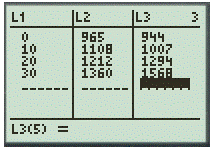
Step 2. Use the LinReg feature with first two list
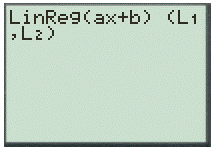
And,
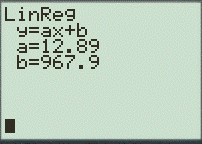
Therefore, the obtained equation is
b.
To calculate: The linear regression equation for the population of Ladho.
The obtained model is
Given Information:
The table is defined,
| Time (years) | Hawaii (thousands) | Ldaho (thousands) |
| 1980 | 965 | 944 |
| 1990 | 1108 | 1007 |
| 2000 | 1212 | 1294 |
| 2010 | 1360 | 1568 |
Calculation:
Consider the given table,
| Time (years) | Hawaii (thousands) | Ldaho (thousands) |
| 1980 | 965 | 944 |
| 1990 | 1108 | 1007 |
| 2000 | 1212 | 1294 |
| 2010 | 1360 | 1568 |
Use a graphing calculator to find the logestic model.
Step 1. Insert the table in calculator by using the table feature.
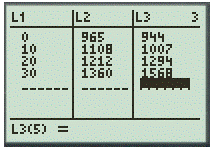
Step 2. Use the LinReg feature with first two list
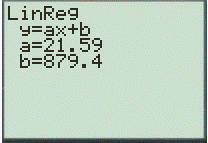
Hence, the obtained result is
c.
To Graph: The models in parts (a) and (b) and use these models to explain when the populations of the two states were about the same.
The obtained graph is defined as,
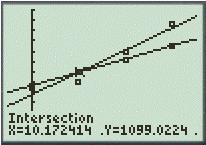
Given Information:
The table is defined,
| Time (years) | Hawaii (thousands) | Ldaho (thousands) |
| 1980 | 965 | 944 |
| 1990 | 1108 | 1007 |
| 2000 | 1212 | 1294 |
| 2010 | 1360 | 1568 |
Calculation:
Consider the given table,
| Time (years) | Hawaii (thousands) | Ldaho (thousands) |
| 1980 | 965 | 944 |
| 1990 | 1108 | 1007 |
| 2000 | 1212 | 1294 |
| 2010 | 1360 | 1568 |
Use a graphing calculator to find the logestic model.
Step 1. Insert the table in calculator by using the table feature.
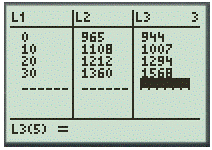
Step 2. Graph the both equations (a) and (b) then use the intersect feature to find the intersection point.
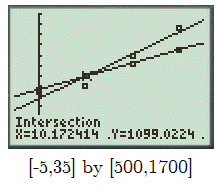
The x -coordinates of the point of intersection is 10.2, and it is representing year 1990.
Hence, the obtained years is 1990.
d.
To determine: The models, which appears to be a better fit for the data and explain which model would you choose to make predictions beyond 2020
Hawaii is having a linear model and Idaho population is having exponential or logistic
Given Information:
The table is defined,
| Time (years) | Hawaii (thousands) | Ldaho (thousands) |
| 1980 | 965 | 944 |
| 1990 | 1108 | 1007 |
| 2000 | 1212 | 1294 |
| 2010 | 1360 | 1568 |
Calculation:
Consider the given information,
The linear model seems to be a good fit for Hawaii as most points appear to be on the line which means that there is almost a constant change in population.
An exponential or a logistic model seems to be appropriate for Idaho since there is a sudden increase in population for the same year intervals which is from 1990 to 2000.
Hence, Hawaii is having a linear model and Idaho population is having exponential or logistic
Chapter 7 Solutions
PRECALCULUS:...COMMON CORE ED.-W/ACCESS
- Calculus lll May I please have the solution for the example? Thank youarrow_forward4. AP CalagaBourd Ten the g stem for 00 3B Quiz 3. The point P has polar coordinates (10, 5). Which of the following is the location of point P in rectangular coordinates? (A) (-5√3,5) (B) (-5,5√3) (C) (5√3,5) (D) (5√3,-5) 7A 6 2 3 4 S 元 3 داند 4/6 Polar axis -0 11 2 3 4 4 5л 3 Зл 2 11π 6 rectangular coordinates of K? The figure shows the polar coordinate system with point P labeled. Point P is rotated an angle of measure clockwise about the origin. The image of this transformation is at the location K (not shown). What are the (A) (-2,2√3) (B) (-2√3,2) (C) (2,-2√3) D) (2√3,-2) T 2arrow_forwardAP CollegeBoard 3B Quiz 1. 2. y AP PRECALCULUS Name: od to dove (or) slog mig Test Boc 2л The figure gives the graphs of four functions labeled A, B, C, and D -1 in the xy-plane. Which is the graph of f(x) = 2 cos¹x ? m -3 π y 2- 1 3 (A) A (B) B 2 A B C D D -1- -2- Graph of f -2 -1 3. 2- y' Graph of g 1 2 1 3 y = R 2/01 y = 1 + 1/2 2 3 4 5 y= = 1-777 2 (C) C (D) D Which of the following defines g(x)? The figure gives the graphs of the functions ƒ and g in the xy-plane. The function f is given by f(x) = tan-1 EVES) (A) (A) tan¹x+1 (B) tan¹ x + 1/ (C) tan¹ (2) +1 (D) tan¹() + (B) Vs) a I.arrow_forward
- Consider the region below f(x) = (11-x), above the x-axis, and between x = 0 and x = 11. Let x; be the midpoint of the ith subinterval. Complete parts a. and b. below. a. Approximate the area of the region using eleven rectangles. Use the midpoints of each subinterval for the heights of the rectangles. The area is approximately square units. (Type an integer or decimal.)arrow_forwardRama/Shutterstock.com Romaset/Shutterstock.com The power station has three different hydroelectric turbines, each with a known (and unique) power function that gives the amount of electric power generated as a function of the water flow arriving at the turbine. The incoming water can be apportioned in different volumes to each turbine, so the goal of this project is to determine how to distribute water among the turbines to give the maximum total energy production for any rate of flow. Using experimental evidence and Bernoulli's equation, the following quadratic models were determined for the power output of each turbine, along with the allowable flows of operation: 6 KW₁ = (-18.89 +0.1277Q1-4.08.10 Q) (170 - 1.6 · 10¯*Q) KW2 = (-24.51 +0.1358Q2-4.69-10 Q¹²) (170 — 1.6 · 10¯*Q) KW3 = (-27.02 +0.1380Q3 -3.84-10-5Q) (170 - 1.6-10-ºQ) where 250 Q1 <1110, 250 Q2 <1110, 250 <3 < 1225 Qi = flow through turbine i in cubic feet per second KW = power generated by turbine i in kilowattsarrow_forwardHello! Please solve this practice problem step by step thanks!arrow_forward
- Hello, I would like step by step solution on this practive problem please and thanks!arrow_forwardHello! Please Solve this Practice Problem Step by Step thanks!arrow_forwarduestion 10 of 12 A Your answer is incorrect. L 0/1 E This problem concerns hybrid cars such as the Toyota Prius that are powered by a gas-engine, electric-motor combination, but can also function in Electric-Vehicle (EV) only mode. The figure below shows the velocity, v, of a 2010 Prius Plug-in Hybrid Prototype operating in normal hybrid mode and EV-only mode, respectively, while accelerating from a stoplight. 1 80 (mph) Normal hybrid- 40 EV-only t (sec) 5 15 25 Assume two identical cars, one running in normal hybrid mode and one running in EV-only mode, accelerate together in a straight path from a stoplight. Approximately how far apart are the cars after 15 seconds? Round your answer to the nearest integer. The cars are 1 feet apart after 15 seconds. Q Search M 34 mlp CHarrow_forward
- Find the volume of the region under the surface z = xy² and above the area bounded by x = y² and x-2y= 8. Round your answer to four decimal places.arrow_forwardУ Suppose that f(x, y) = · at which {(x, y) | 0≤ x ≤ 2,-x≤ y ≤√x}. 1+x D Q Then the double integral of f(x, y) over D is || | f(x, y)dxdy = | Round your answer to four decimal places.arrow_forwardD The region D above can be describe in two ways. 1. If we visualize the region having "top" and "bottom" boundaries, express each as functions of and provide the interval of x-values that covers the entire region. "top" boundary 92(x) = | "bottom" boundary 91(x) = interval of values that covers the region = 2. If we visualize the region having "right" and "left" boundaries, express each as functions of y and provide the interval of y-values that covers the entire region. "right" boundary f2(y) = | "left" boundary fi(y) =| interval of y values that covers the region =arrow_forward
 Calculus: Early TranscendentalsCalculusISBN:9781285741550Author:James StewartPublisher:Cengage Learning
Calculus: Early TranscendentalsCalculusISBN:9781285741550Author:James StewartPublisher:Cengage Learning Thomas' Calculus (14th Edition)CalculusISBN:9780134438986Author:Joel R. Hass, Christopher E. Heil, Maurice D. WeirPublisher:PEARSON
Thomas' Calculus (14th Edition)CalculusISBN:9780134438986Author:Joel R. Hass, Christopher E. Heil, Maurice D. WeirPublisher:PEARSON Calculus: Early Transcendentals (3rd Edition)CalculusISBN:9780134763644Author:William L. Briggs, Lyle Cochran, Bernard Gillett, Eric SchulzPublisher:PEARSON
Calculus: Early Transcendentals (3rd Edition)CalculusISBN:9780134763644Author:William L. Briggs, Lyle Cochran, Bernard Gillett, Eric SchulzPublisher:PEARSON Calculus: Early TranscendentalsCalculusISBN:9781319050740Author:Jon Rogawski, Colin Adams, Robert FranzosaPublisher:W. H. Freeman
Calculus: Early TranscendentalsCalculusISBN:9781319050740Author:Jon Rogawski, Colin Adams, Robert FranzosaPublisher:W. H. Freeman
 Calculus: Early Transcendental FunctionsCalculusISBN:9781337552516Author:Ron Larson, Bruce H. EdwardsPublisher:Cengage Learning
Calculus: Early Transcendental FunctionsCalculusISBN:9781337552516Author:Ron Larson, Bruce H. EdwardsPublisher:Cengage Learning





